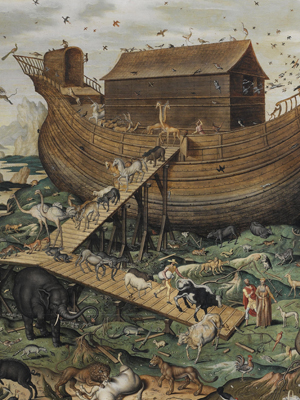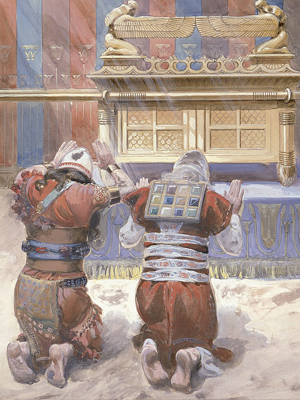Masonic Articles and Essays
What is an Ark?
Very Illus..... Bro. Kristine Wilson-Slack 33o
Date Published:
11/16/2023
The ark is a symbol known to humanity from ancient times, common across many cultures and religions. What is its significance to freemasonry and what esoteric secrets can be revealed through understanding its inner meanings?
Symbols, especially of the commonly-accepted-but-never-thought-of-kind, can be highly engaging. They may even drive us down rabbit holes. One such, for me, is an “ark.” I wondered, what it meant to be in an ark, why are there three arks in the bible, and yet, not many anywhere else? What is the significance of an ark, and what is its purpose? What is the symbol attempting to say?
 Let’s start with a definition: an ark is a place of safety and protection. Whether it’s a boat, chest, or cabinet, it protects something precious. The arks in the Bible are all in the Old Testament and as such, are related to Jewish events. The first is the Ark of Noah, in which all holy and righteous life on Earth was rescued from the Lord’s flood. The second is the Ark of the Covenant, which is also known as the Ark of Samuel, the Ark of Testimony, and the Ark of God. Inside it were placed three items: the tablets of the Ten Commandments, a pot of manna, and Aaron’s Rod. The last ark is the Ark of Moses, also known as the ark of bulrushes. This is the papyrus (bulrush) basket in which Moses was placed when he was sent away by his birth mother. The word in Egyptian (teb) translates to the same word used for ark (aron) in Hebrew.
Let’s start with a definition: an ark is a place of safety and protection. Whether it’s a boat, chest, or cabinet, it protects something precious. The arks in the Bible are all in the Old Testament and as such, are related to Jewish events. The first is the Ark of Noah, in which all holy and righteous life on Earth was rescued from the Lord’s flood. The second is the Ark of the Covenant, which is also known as the Ark of Samuel, the Ark of Testimony, and the Ark of God. Inside it were placed three items: the tablets of the Ten Commandments, a pot of manna, and Aaron’s Rod. The last ark is the Ark of Moses, also known as the ark of bulrushes. This is the papyrus (bulrush) basket in which Moses was placed when he was sent away by his birth mother. The word in Egyptian (teb) translates to the same word used for ark (aron) in Hebrew.
There is also one more ark, not specifically noted as such in the bible, and might not be known to those who do not practice the Jewish faith. This ark is “a repository traditionally in or against the wall of a synagogue for the scrolls of the Torah.” Among the Ashkenazim, it is known as the “aron kodesh” or “Holy Ark,” which comes from Chronicles II 35:3, which indicates where the ark in the temple should be located. This location is the wall that resides closest to the Temple Mount. There are many traditions and customs associated with this particular ark. The most interesting is that the ark may never be empty; on holy days like Rosh Hashanah, when the scrolls are removed from the ark, a lit candle is placed in the ark to represent the light of the Torah.
In Freemasonry, there is a specific degree tied to the Ark of Noah, named the Royal Ark Mariner degree. This degree is speculated to have been used prior to Blue Lodge Masonry and is considered by some to be an influence on Craft Freemasonry. The presence of the Ark and Anchor within Craft Masonry is what causes this theory to surface. There is no known date from when this degree originates and in Masonic literature, it is only first mentioned in the 18th C. The degree is worked in Scotland, England, and the United States (as an Allied Degree) by different masculine orders and is part of the Universal Freemasonry rite.
 Moving back to the symbolism of the ark in Freemasonry, the ark of Noah and the ark of the covenant are the symbols most seen in ritual. If we look back towards the mysteries of Egypt, archeologists are now finding that arks like that described as the Ark of the Covenant were carried in “the Procession of the Shrines.” The Egyptians are believed to have used their arks as places of sacred worship and to dispense the will of the Divine. In the Procession, these arks were carried to the appropriate Temple, and ceremonies were performed on or next to them. They also carried precious objects of a mystical nature, such as statues of Gods or other relics. The “angels” on the Egyptian arks were said to be of gods or goddesses to whom the ark “housed.” Some have speculated that the beings on the ark represented Truth and Justice, such as the goddess Ma’at. One site mentions the goddess Theme but there does not appear to be a goddess in ancient Egypt with this name.
Moving back to the symbolism of the ark in Freemasonry, the ark of Noah and the ark of the covenant are the symbols most seen in ritual. If we look back towards the mysteries of Egypt, archeologists are now finding that arks like that described as the Ark of the Covenant were carried in “the Procession of the Shrines.” The Egyptians are believed to have used their arks as places of sacred worship and to dispense the will of the Divine. In the Procession, these arks were carried to the appropriate Temple, and ceremonies were performed on or next to them. They also carried precious objects of a mystical nature, such as statues of Gods or other relics. The “angels” on the Egyptian arks were said to be of gods or goddesses to whom the ark “housed.” Some have speculated that the beings on the ark represented Truth and Justice, such as the goddess Ma’at. One site mentions the goddess Theme but there does not appear to be a goddess in ancient Egypt with this name.
The common theme amongst all of the arks is the protection of something precious. Be it the word of God, the prophet of God, relics, or the righteous life on Earth, the items inside were of a mystical and divine nature. It’s necessary that these precious items be protected from desecration and destruction, but the question is from whom or what? Do we protect them from the profane? That begs many questions, especially about the Ark of Noah. The arks are greater symbols, to be sure, of several esoteric concepts, like Brotherhood, Fidelity, and Reverence. It bears exploring these symbols in the context of the Masonic rituals in which they appear, and look deeper than the surface meaning of protection.
More Masonic Articles
Explore articles and essays written by Freemasons about Freemasonry.
Read More
Membership
Interested in becoming a member of the worlds oldest Fraternal organization?
Read More